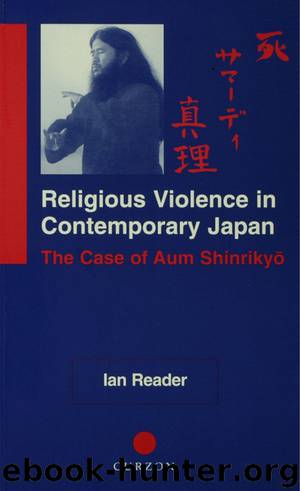Religious Violence in Contemporary Japan: The Case of Aum Shinrikyo (NIAS Monographs) by Reader Ian

Author:Reader, Ian [Reader, Ian]
Language: eng
Format: epub
Publisher: Taylor and Francis
Published: 2013-10-11T00:00:00+00:00
AN EXERCISE IN COMPASSION: THE MURDER OF THE SAKAMOTO FAMILY
Even though Aum had just won official status under the Religious Corporations Law, fears and doubts continued to exist within the movement’s upper echelons. The deaths of Majima and Taguchi remained dangerous secrets that threatened to undermine the existence of the movement and the freedom of its leaders at any moment. Asahara was clearly troubled by these events and appeared, in autumn 1989, to be extremely pessimistic about the future. He complained that no one listened to his messages of truth, preferring instead to wallow in hedonism and to choose (as he saw it) the path to hell, and he fretted about the possible collapse of his movement. A number of quite senior shukkesha, he announced, had recently ‘fallen’ from grace and left the movement: they would, for these karmic sins, inevitably fall into the lowest hells as result of their defections. The defections disturbed him because they suggested that Aum’s support was ebbing away and he feared that Aum itself would collapse unless he took steps to increase support and raise its profile.58 It was for such reasons, he informed disciples, that he had taken the decision to enter the political arena and contest the parliamentary elections of February 1990.
Before the election, however, other serious problems arose. In October 1989 the Sunday Mainichi, a weekly magazine published by the Mainichi newspaper group, began a series of seven articles that were highly critical of Aum. Aum was accused, amongst other things, of exploiting its followers through the use of expensive and strange initiation rituals, and of breaking up families by refusing to allow those with relatives or offspring inside Aum to have any communication with them, while Asahara was portrayed as an exploitative and manipulative leader with an overbearing ego. While the tone of the articles was sensationalist, they were not out of the ordinary in Japan, where the mass media have made a habit of dirt-digging and running ‘scandal’ stories about religious movements in general and the new, and very’ new, religions in particular. However, the contents of the articles caused grave offence to Aum and, coming not long after the initial rejection of its application for legal religious recognition and the defections of a number of close followers, added fuel to Asahara’s fear that hostile forces were working against Aum. A former member I interviewed in 1997 told me that Asahara had been extremely angry at this time because of the magazine articles.59 Asahara went on the attack again, filing lawsuits against the magazine and making verbal assaults on its editor, Maki Tarō.
The articles produced a widespread response from the public. The magazine received well over 200 communications from people with complaints against Aum, including former members who said they had paid for costly initiations that failed to give them any spiritual benefits. These various complainants were put in touch with one another by the magazine, and a protest group called the Oumu Shinrikyō higaisha no kai [Aum Shinrikyō Victims’ Society] was established.
Download
This site does not store any files on its server. We only index and link to content provided by other sites. Please contact the content providers to delete copyright contents if any and email us, we'll remove relevant links or contents immediately.
| Elections & Political Process | Ideologies & Doctrines |
| International & World Politics | Political Science |
| Public Affairs & Policy | Specific Topics |
| United States |
The Secret History by Donna Tartt(18843)
The Social Justice Warrior Handbook by Lisa De Pasquale(12141)
Thirteen Reasons Why by Jay Asher(8792)
This Is How You Lose Her by Junot Diaz(6794)
Weapons of Math Destruction by Cathy O'Neil(6142)
Zero to One by Peter Thiel(5685)
Beartown by Fredrik Backman(5596)
The Myth of the Strong Leader by Archie Brown(5425)
The Fire Next Time by James Baldwin(5248)
How Democracies Die by Steven Levitsky & Daniel Ziblatt(5127)
Promise Me, Dad by Joe Biden(5087)
Stone's Rules by Roger Stone(5026)
A Higher Loyalty: Truth, Lies, and Leadership by James Comey(4843)
100 Deadly Skills by Clint Emerson(4840)
Rise and Kill First by Ronen Bergman(4701)
Secrecy World by Jake Bernstein(4644)
The David Icke Guide to the Global Conspiracy (and how to end it) by David Icke(4624)
The Farm by Tom Rob Smith(4434)
The Doomsday Machine by Daniel Ellsberg(4415)
